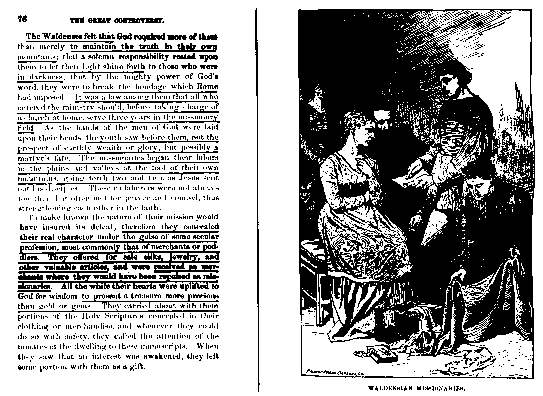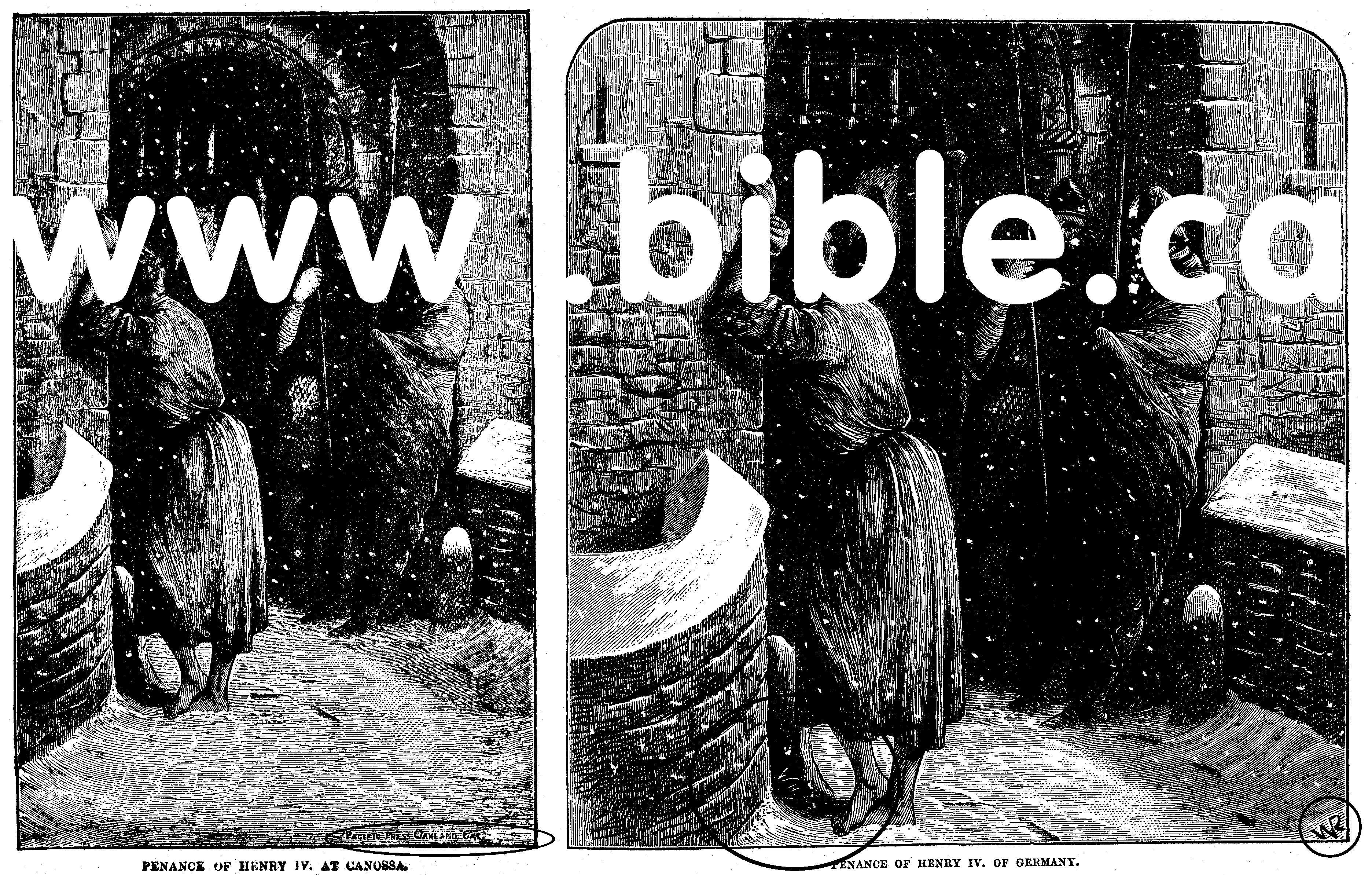White copied "The Great Controversy" 1886, from "The History of Protestantism" 1876.
She not only copied the words, but the pictures too! Then claimed it was a revelation of God!
|
|
Ellen G. WhiteProphet?or Plagiarist!The White Lie! |
Actual photocopy of "The Great Controversy", By Ellen G. White
Original 1886 edition pages 76-77
Changed from current edition, Underlined sections were copied!

Here is where White Copied from:
Actual photocopy ofWhite copied extensively from this book and claimed it was a revelation from God! |
Click on photos for ultra high resolution
|
Click on photos for ultra high resolution Left: The Great Controversy.................... Right Wylie's book Notice that White was an experienced plagiarist and actually deleted the original scribal artist's signature and inserted her publishing company! This is just one of many examples of artwork theft. Offenses include: replacing original scribes signature HOOPER SC, with "Pacific Press Oakland, Cal." These pictures were produced from the drawings of an artist, then a scribe would etch into wood or metal, a copy of the drawing for printing. The original artist's initials appear to be in the right hand part of the photo as "CC". Although this is not certain and no one knows if CC really is the initials of the name of the artist. It could be an abbreviation for carbon copy, meaning it was a duplicate of the original. Notice in the left hand corner of the picture in Wylie's book is HOOPER SC. This may stand for, HOOPER, the SC may be an abbreviation for "scribe" or "sculpsit" who etched the picture onto the printing press medium. Now it is argued that since White had the drawing "re-etched" into a printing medium a second time, that means she can drop "HOOPER SC" and put her own in its place. That would only be legal if they had the original drawing, which they did not. Since the picture was scribed a second time, from Hooper's scribal etching, White was obligated to leave Hooper's name on, and only then could White put her own on the drawing. In the art world, If you repaint a "Mono Lisa" from a drawing someone else made of the original, you must give credit to the one whose drawing you used! But if White really was above board and felt she had the right to remove "HOOPER SC" because she had it scribed onto metal a second time, why did she not put 'SC" after "Pacific Press Oakland, Cal." so that it looked this way: "Pacific Press Oakland, Cal. SC" So white is just a plagiarist, no matter how you look at it! Remember, all this material comes out of book called, "The White Lie" written by Walter Rae, who has been an ordained Seventh-Day Adventist pastor for 40 years and even today, is a member in good standing, attends Sabbath service every Saturday and is still an ordained Pastor in the Seventh-Day Adventist church. We did not write this material, we merely reported it directly out of Pastor Rae's book! (Notice, we always give credit for our source!) To White's credit, she did buy the rights to use all these pictures. But that is not the issue. If I buy the right to use someone else's photos, I cannot put my name on it and pass it off as my own work. Money doesn't make an artist. Lets not forget and make it very clear, is that she plagiarized the words beside the picture without giving credit as well! She not only copied the pictures, she copied the words right beside the picture and claimed it a revelation of the Holy Spirit! (The back cover of the Great Controversy, tells the reader White was an prophet inspired by the Holy Spirit.) Wow I think I will visit the library and get some inspiration! I can get real inspired with a photocopier! Imagine what White could have done with modern scanners and OCR programs! "The whole world could not contain the her inspired words!" And for anyone who is not convicted that the charge White removed the original artist's name and replaced it with her own... Keep reading, it gets worse! |
Replacing the artists initials WR with her own, without giving credit:
Here is another example from Walter Rae's Book, The White Lie, where White deleted the signature of the artist and replaced it with her Publishing Company, giving no credit to the original artist. Left is from the Great Controversy, Right is the original artwork she copied it from without giving credit to the original artist who drew the picture. You can see the initials at the bottom right: WR. Notice that the picture was re-drawn but they cropped the picture in the Great Controversy so that it was narrower (left photo) so that it cuts off the artists name!
Click on photos for ultra high resolution

Click on photos for ultra high resolution
Incredible close-up of lower left hand and right hand corners of both pictures.
Right is the initials of the original artist "WR". Left from White's book says: "Pacific Press Oakland, Cal."
Right below the leg, is seems to be the initials "WH". But the W is not clear. Likely it is another "WR". So this would mean that the author put his name on his artwork TWICE and White removed it twice and put her own name on it.
White copied not only the Pictures, but also the words! |
|
Text from The Great controversy by White in the photocopy above. |
Text from The History of Protestantism by Wylie in the photocopy above. |
|
Red sections indicate what was copied |
|
|
The Waldenses felt that God required more of them than merely to maintain the truth in their own mountains; that a solemn responsibility rested upon them to let their light shine forth to those who were in darkness; that by the mighty power of God's word, they were to break the bondage which Rome had imposed. It was a law among them that all who entered the ministry should, before taking charge of a church at home, serve three years in the missionary field. As the hands of the men of God were laid upon their heads, the youth saw before them, not the prospect of earthly wealth or glory, but possibly a martyr's fate. The missionaries began their labors in the plains and valleys at the foot of their own mountains, going forth two and two, as Jesus sent out his disciples. These colaborers were not always together, but often met for prayer and counsel, thus strengthening each other in the faith. To make known the nature of their mission would have insured its defeat; therefore they concealed their real character under the guise of some secular profession, most commonly that of merchants or peddlers. They offered for sale silks, Jewelry, and other valuable articles, and were received as merchants where they would have been repulsed as missionaries. All the while their hearts were uplifted to God for wisdom to present a treasure more precious than gold or gems. They carried about with them portions of the Holy Scriptures concealed in their clothing or merchandise, and whenever they could do so with safety, they called the attention of the inmates of the dwelling to these manuscripts. When they saw that an interest was awakened, they left some portion with them as a gift. (White, 1886) |
Whom they traded, and the landlords in whose houses they lodge. The priests seldom carried to meet in argument the Waldensian missionary. To maintain the truth in their own mountains was not the only object of this people. They felt their relations to the rest of the Christendom. They sought to drive back the darkness, and re-conquer the kingdoms which Rome had overwhelmed. They were an evangelistic as well as an evangelical Church. It was an old law among them that all who took orders in their church should, before being eligible to a home charge, serve three years in the mission field. The youth on whose head the assembled barbes laid their hands, saw in prospect not a rich benefice, but a possible martyrdom. The ocean they did not cross. Their mission field was the realms that lay outspread at the foot of their own mountains. They went forth two and two, concealed their real character under the guise of a secular profession, most commonly that of merchants or pedlars. They carried silks, jewellery, and other articles, at that time not easily purchasable save at distant marts, and they were welcomed as merchants where they would have been spurned as missionaries. The door of the cottage and the portal of the baron's castle stood equally open to them. But their address was mainly shown in vending, without money and without price, rarer and more valuable merchandise than the gems and silks which had..." (Wylie, 1876) |
![]() Order Walter Rea's book: "The White Lie"
Order Walter Rea's book: "The White Lie"
![]()
We Speak truth in LOVE
"you are seeking to kill Me, a man who has told you the truth" Jn 8:40
![]()